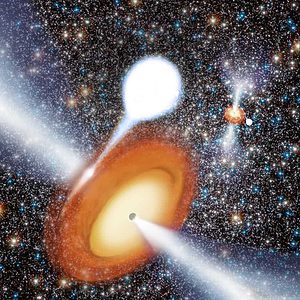Black holes are simply the worst neighbors to have around, as they wreck havoc in their vicinity. Scientific belief states, however, that in a globular cluster, which is a massive spherical conglomeration of thousands of thousands of stars, you can’t have more than one black hole, if any. New findings however show that there’s no safe neighborhood, as data suggests black holes may reside in pairs in star clusters.
“Before this work, there were zero black holes known in Milky Way globular clusters, so even finding one would have been exciting,” said lead study author Jay Strader, an astronomer at Michigan State University in East Lansing.

Initially, the researchers used the recently upgraded Very Large Array (VLA), a network of radio dishes near Socorro, N.M., to look for an intermediate-mass black hole at the center of M22, a globular cluster 10,000 light years away. Now, although they didn’t find the central black hole they were after in the first place, they stumbled across something a whole lot more valuable. Intermediate-mass black holes have a mass of around a few thousand times that of our sun. Supermassive blackholes, commonly found at the center of galaxies, weigh millions to billions times the mass of our sun. In M22 the astronomers found a pair of even lighter black holes that form from the collapse of massive stars – each are only 10 to 20 times the mass of the sun.
These black holes are both binary systems, each possessing a companion star from which they are ripping matter from like a vampire. Matter from the stars, like gas and dust, is drained and collected by the black hole, much like water swirling down a drain.
“One of the most interesting aspects of this work is that we found the black holes via radio emission,” Strader said. “All the other stellar-mass black holes in our galaxy have been discovered by X-ray emission rather than radio. We hypothesize that the reason our sources haven’t been seen in previous X-ray searches is that they aren’t accreting very much matter at all, so they don’t produce the hot accretion disks that glow in the optical and X-rays.
Theories say that that there may be few or no black holes in a globular cluster, as gravitational interactions between black holes in the cluster would eject almost all the black holes in short order. The two black holes, named M22-VLA1 and M22-VLA2, provide counter evidence to these theories. Strader and colleagues estimate that there could be as many as 100 low-mass black holes in the globular cluster.
“Future computer simulations of the evolution of globular clusters with populations of black holes should help address this issue,” Strader said.
He added, “My personal view is that it’s likely that other clusters also have black holes that we just haven’t found yet.”
The astronomers from the U.S., England and Australia announced their discovery in a study published in the October 4 issue of Nature.


